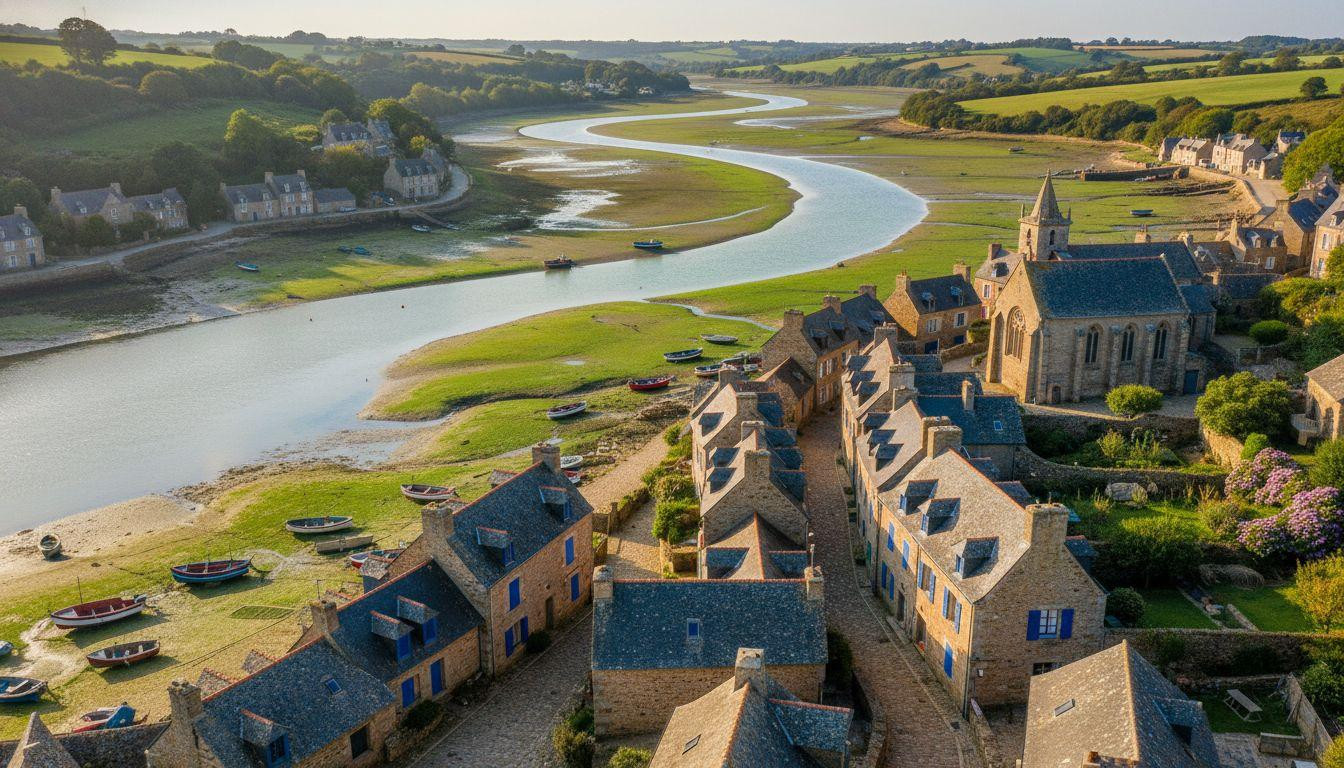At 6:47 AM, November light touches the Rance River estuary where 977 residents prepare for another quiet day. Honey-colored stone walls catch the golden hour as fishing boats rest on emerald mudflats. Nine miles away, millions crowd Saint-Malo’s ramparts each year.
Here in Saint-Suliac, cobblestone streets stretch empty beneath hydrangeas still blooming in autumn warmth. This is one of France’s Most Beautiful Villages, where 13th-century fishing heritage survives without commercializing it.
Where Brittany’s Rance River meets forgotten coastal beauty
Saint-Suliac clings to the Rance estuary 6 miles southeast of Saint-Malo, accessible by winding roads through Ille-et-Vilaine countryside. From major US cities, travelers fly to Paris CDG (7-12 hours depending on origin), then TGV to Rennes (1.5-2 hours, $38-$76).
The 45-60 minute drive through hedgerow-lined Breton lanes reveals dramatic river bends where tidal waters shift from turquoise to emerald to sapphire six times daily. November temperatures hover around 50-61°F, with golden autumn light perfect for photography minus summer’s crowds.
GPS coordinates (48.619°N, -1.951°W) place this 2.1 square mile village 34 miles from Rennes, 198 miles northwest of Paris. The village of Beuvron-en-Auge shares similar Plus Beaux Villages designation and intimate scale.
The village where 13th-century stones still tell fishing stories
Architecture that shipbuilders built for themselves
Narrow streets called “ruettes” wind between houses constructed by cod fishermen who sailed to Newfoundland centuries ago. Honey-colored granite walls absorb morning sun, warming to amber by 4:00 PM November sunsets.
Cobalt-blue shutters contrast against grey-slate roofs unchanged since the Middle Ages. Sculptures of the Virgin Mary embedded in stone walls date to 1800s village protection rituals against illness.
Tidal drama that paints water six colors daily
The Rance estuary creates constantly-shifting landscapes invisible in standard seas. High tide brings turquoise-blue waters lapping stone quays at 7:23 AM and 7:49 PM today.
Mid-tide reveals emerald shallows dotted with sailboats. Low tide at 1:35 PM exposes sapphire channels through golden mudflats. November light transforms these 24-28 foot tidal transitions into photographer’s gold.
What 977 residents protect from mass tourism
Riverside trails where you’ll walk alone
The Sentier des Pêcheurs traces 1.4 miles along Rance shoreline through verdant hills offering panoramic views. Unlike Saint-Malo’s shoulder-to-shoulder rampart walks (4 million annual visitors), these trails remain empty even in peak season.
Villages like Castelnou share this authentic preservation without tourist markup. November reveals autumn’s hydrangeas still blooming, wild thyme releasing scent along footpaths, seabirds gathering on exposed mudflats.
Breton cuisine without tourist markup
Village bistros serve authentic galettes (buckwheat pancakes) for $16, fresh mussels for $21, and morning-harvested oysters for $18 per half-dozen. Compare that to Saint-Malo’s $25-$65 tourist pricing.
Local cider made from Brittany apples accompanies meals in stone-walled dining rooms where 19th-century maritime tools decorate walls. Markets sell salted butter caramel, artisan pottery, and wool textiles crafted by village artisans maintaining traditional Breton crafts.
Why this matters more than Saint-Malo’s crowds
Saint-Suliac preserves what mass tourism destroys: working maritime culture where 12 fishermen still mend nets at dawn. Here, 977 residents live authentic coastal lives versus performing for cameras, where architecture evolved organically over 800 years.
The Plus Beaux Villages de France designation protects this integrity with strict building codes and development restrictions. November reveals this truth clearest: while Saint-Malo’s ramparts echo with tour group chatter, Saint-Suliac’s cobblestones remain silent except for seagull cries.
Similar medieval French villages maintain this authentic character through careful preservation.
Your Questions About Saint-Suliac, France’s hidden Breton village answered
How do I actually reach this village from Paris?
Take TGV from Paris Gare Montparnasse to Rennes (1.5-2 hours, book early for $38-$54), then rent car at Rennes station ($42-$87/day) for 34-mile drive through Brittany countryside. Alternatively, train to Saint-Malo (2.5 hours direct) then 6-mile taxi ride ($31-$38).
What makes Breton maritime culture different here?
Saint-Suliac preserves actual fishing village life versus performing it. Fishermen depart at 4:30 AM for day’s catch, village festivals celebrate sailing heritage authentically, and architectural preservation maintains 13th-century character because residents live in these homes.
How does this compare to Brittany’s other coastal villages?
Saint-Suliac offers authentic maritime heritage Cancale commercialized, tidal drama Mont-Saint-Michel crowds obscure, and coastal beauty Dinard priced out of reach. Maritime villages like Bar Harbor share similar working waterfront authenticity.
At 25,000-30,000 annual visitors versus Saint-Malo’s 4 million, it maintains village soul. Accommodation costs run 45% below regional tourist hotspots: $107-$142 nightly versus $246+ in Saint-Malo.
At 5:47 PM, low November sun turns honey-stone walls to amber gold while falling tide reveals emerald channels through mudflats. A fisherman coils rope on his boat resting in wet sand. The 13th-century church bell rings six times across the Rance, where the village glows timeless and unhurried.
